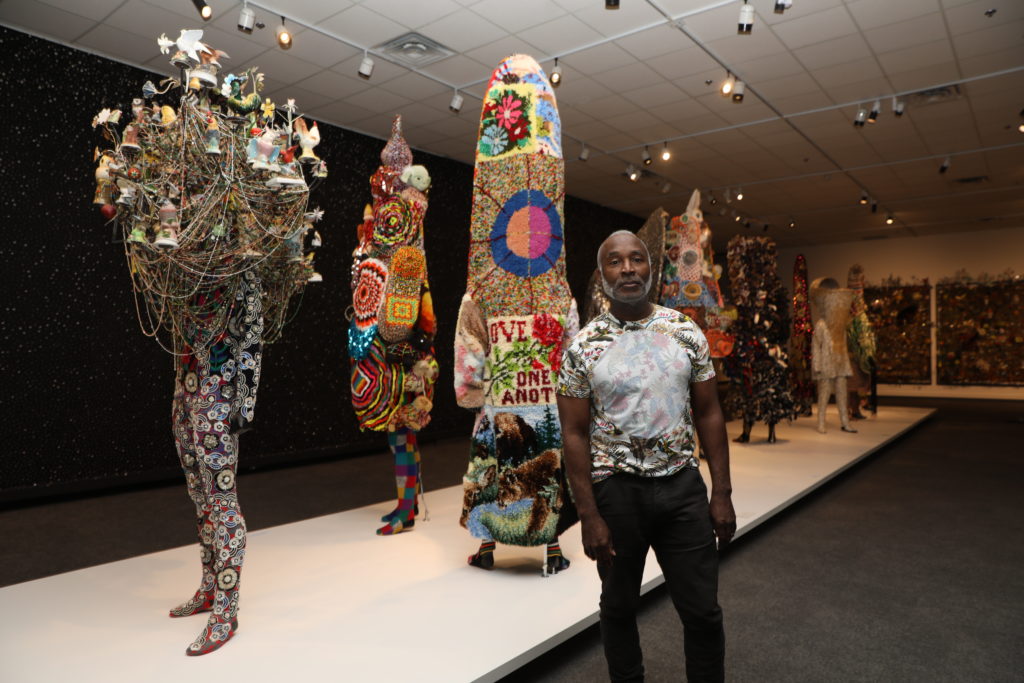An incredibly prolific visual artist, performer and educator, Nick Cave possesses a kind of rare energy that keeps him always in action—despite an often gruelling schedule. He is highly in demand around the world and is hands-on with every project. This June he was immersed in the details of the installation of “Nick Cave: Feat.” at Glenbow Museum in Calgary—his first monographic exhibition in Canada.
Nick Cave’s artworks are boundary-eradicating explosions of form, colour and meaning. His most famous creation, the Soundsuit, is a kind of richly textured wearable sculpture adorned with multitudes of found objects. The first Soundsuit was created in response to the 1992 beating of African American motorist Rodney King by Los Angeles police officers. Since then, Cave has produced more than 500 Soundsuits, often in response to tragic events involving gun violence, racism and injustice.
The centrepiece of the exhibition at Glenbow is a runway of Soundsuits—each one is fantastical, exuberant, bursting with colour and texture. Cave sees them as bristling suits of armour to obscure race, gender, class and identity. But Cave doesn’t dwell on tragedy. With his art, he hopes to spark imaginations and inspire compassion, mutual understanding and collective dreaming.
The runway serves as a kind of gateway into what exhibition curator Katie Delmez refers to as “the maximalist world” of Nick Cave. Presented as “mini-survey” of the artist’s career to date, “Nick Cave: Feat.” includes sculpture, video and immersive environments.
As installation of the exhibition neared completion at Glenbow in early June, Cave took a moment to discuss his practice.
In the past, you’ve mentioned the transformative nature of the Soundsuits—quite literally, they are all designed to be worn by you. What is the experience of wearing a Soundsuit like?
Well, I’m telling you it’s not so easy. The most critical thing is the transformation—how do you sort of surrender to becoming something “other.” It’s really a process. When I’m working with a group of performers, I do not have any of them put on the Soundsuits right away. I will have you sit in front of it. I will have you touch it. I will have you pick it up and see what it feels like, weight-wise. Then we talk about, “What type of motion do you think you will you bring to this object? What are you thinking? Let’s talk through it.” Then I will allow you to put it on but remain still, which is the transition. Can you remain still and then be open to [the fact] that your identity is no longer revealed? What does this mean? What are you?
You’re a prolific artist. How did you choose these particular pieces for what is essentially a mini survey?
Yes: mini. What ties it all together is…the hand. The way things are fabricated. You can tell it’s built by hand. You can tell that it’s a maker who makes this work—it’s this physical way of building and developing these amazing surfaces. It’s also all about life and the circumstances that we struggle with, or that I’m struggling with daily based around race and violence. There’s a social foundation that is really the fuel that forces me to do what I do.
There are some quite dark underpinnings to much of the work, yet it’s a safe bet that many people’s initial reaction to seeing it would be joy.
For me it’s optimism. In spite of all the darkness, you know, there’s the other side. We live in a world where we have to somehow identify and establish balance. Although there are times and circumstances where it’s very dark…. For me, darkness means empowerment. What is my responsibility as a citizen to be proactive and to be of service and to make a difference?

 Nick Cave with his Soundsuits in the exhibition Feat. at Glenbow Museum in Calgary, 2019. Photo: Zoltan Varadi.
Nick Cave with his Soundsuits in the exhibition Feat. at Glenbow Museum in Calgary, 2019. Photo: Zoltan Varadi.



